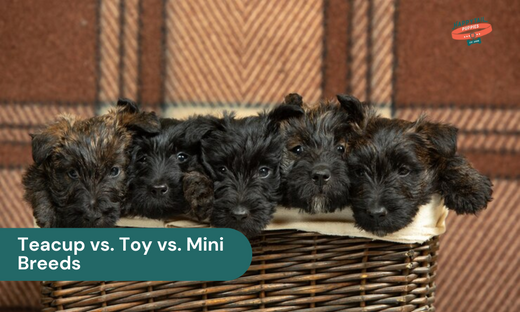Teacup vs. Toy vs. Mini Breeds: Understanding the Differences and Choosing the Right One for You
Teacup, toy, and miniature dog breeds are adored for their compact sizes and unique traits. Explore their differences in size, care, and temperament to find your ideal furry friend.
Arriving at the topic of small dog breeds, the options are huge. It is extremely important to know about the varied categories of small dog breeds if you plan on getting a dog for the first time or are in search of downsizing your furry companion. Among the prominent ones are the teacup, toy, and miniature breeds. These are the three categories that are often considered mainly due to their small size with distinctive qualities, features and care needs. Selecting the best breed consists of numerous considerations of your living conditions, lifestyle, and caring for small dogs. In our posts today, we are going to scour through the main differences between teacup, toy, and miniature dog breeds that will help you land on your choice.
Overview of Small Dog Categories and Why They're Popular
Small dogs have recently become very popular because they offer the ideal blend of personality, compact size, and greater adaptability. Several small dog breeds are well-suited to live in apartments, as they often need less food and exercise than larger dogs. Their loving and portable natures make them the ideal option for families, seniors, and singles.
The teacup, toy, and miniature breeds are the different categories that define small dogs. Although they appear identical, these categories often differ in size, health concerns, temperament, and suitability for different families. Knowing the key dissimilarities between them can help you narrow down the breed that matches your lifestyle and requirements.
What Defines a Teacup Dog?
The teacup dogs are often noted as the extreme version of the toy dog breeds. These dogs are bred to become astonishingly tiny, generally weighing around 4 pounds when they are grown completely. Their miniature sizes might appear captivating; however, the potential owners need to know about the several intricacies that get tagged along with caring for the small dogs.
Size and Weight
As the name projects, the Teacup dogs are the smallest among the small dog breeds. Typically, the dogs often weigh between 2 to 4 pounds whenever they are grown completely. Their tinier sizes are often achieved through selective breeding, involving selecting the smallest dogs from the lineage of the breed. Although they appear loving and convenient to carry around, these teacup dogs are often fragile. Their bones are brittle, and organs, including the lungs and heart, are considerably smaller and more prone to damage or stress. It is due to the size that the teacup dogs fit ideally in the handbag or get carried around; however, it is quite deceptive in terms of convenience, with the dogs requiring further care than what one would expect.
Health Considerations
One key factor to consider with Teacup dogs revolves around their health. Since they are bred smaller than the typical toy breeds, teacups face notable challenges regarding their health. The organ and bone sizes might fail to develop in proportion, leading to issues like fragile bones, heart diseases, and respiratory health issues. Furthermore, their compact sizes can make them prone to injuries. Consequently, teacup dogs need intricate handling, proper vet check-ups, and specialized care.
Care Requirements
The teacup dogs need additional attention, considering their nutrition, living conditions, and exercises. Their compact sizes mean that they can hardly handle rough plays or more physical activities. Furthermore, the Teacups are prone to face issues such as low blood sugar. Therefore, it is important to maintain a well-balanced, nutritious diet. The teacup dogs thrive in spaces where they get pampered and looked after with great care. The owners should stay prepared to offer a consistent level of attention that will keep their pup healthier and happier.
Understanding Toy Breeds
Toy breeds are yet another group of small dogs between the Miniature and Teacup categories. They generally weigh 4 to 8 pounds and stand 6 to 10 inches tall. Toy breeds are prominent for their loving personalities and overall suitability for families in search of a manageable pet. Unlike teacup dogs, toy breeds are staunch and less fragile, making them the practical choice for a few owners.

Traits of Toy Breeds
Toy breeds are often distinguished by their high energy levels, loving nature, and playfulness. Despite their compact sizes, they are known for their alert nature, making them ideal watchdogs. Toy breeds such as the Shih Tzu and Yorkshire Terriers are well-known for their overwhelming loyalty to their owners. Due to their smartness, several toy dogs are trainable; however, they need better attention to prevent undesirable behaviors involving excessive barking.
Examples of Toy Breeds
Chihuahua: This pup is well-known for its loyalty and spunky personality. It is the smallest toy breed, weighing 2 to 6 pounds.
Shih Tzu: These loving dogs are truly affectionate and ideal with families with flowing long coats that need proper grooming.
Pomeranian: The Pomeranians are friendly and fluffy toy breeds who love being the center of attention and active dogs.
Suitability for Families
Toy dog breeds are ideal for families with older adults and children. Their friendly nature and manageable size make them easier to manage, as they need training and socialization. These toy breeds are well-suited to living in apartments and thrive with optimal exercise levels. However, they are often vocal and need a bit more training to curb their barking tendencies.
What Are Miniature Breeds?
Miniature breeds are larger than Toy breeds, which generally weigh between 10 and 20 pounds and stand between 10 and 16 inches tall. However, they are considered small, and they often have staunch builds compared to Toy and Teacup dogs. Miniature dogs are often bred to maintain their compact size while retaining the personalities and attributes of their larger counterparts.
History of Miniature Breeds
Miniature dogs are often bred over the centuries for different reasons, including companionship, hunting, along working dogs. These breeds are the smaller counterparts of the bigger breeds who plan on getting, the smaller companion without impacting the inherited traits of the breed. For instance, the Miniature Schnauzers are bred mainly from the Standard Schnauzers.

Characteristics of Miniature Breeds
Miniature breeds are well-known for their robust characteristics, which display similar smartness and energy to their bigger counterparts. Several miniature breeds are often active and playful but require manageable exercise levels, making them the ideal choice for people with moderate levels of activity. Miniatures often have strong bodies and are less prone to the health issues found among Teacup dogs.
Key Differences Between Teacup, Toy, and Miniature Breeds
Since the three types of small dog breeds share similar qualities, their real difference lies in the manner in which they are cared for and their overall size.
Size and Weight
The most noticeable dissimilarities between the breeds are influenced by their sizes. These teacup dogs are the smallest among the three, weighing between 2 and 4 pounds whenever they are completely grown. Their tiny sizes often make them weaker and call for careful handling. Alternatively, the toy breeds are a bit bigger compared to the teacup sizes, weighing around 4 to 12 pounds. These dogs are small comparatively in smaller-sized apartments or homes; however, they are sturdier than the teacups. The miniature breeds are bigger than the teacup and toy, weighing around 10 and 20 pounds. Although they are considered as small they have stronger builds than the teacup or toy dogs.
Health Concerns
The teacup dogs are often more prone to health-related issues. Their overall compact sizes would lead to an array of medical issues that include heart murmurs, weaker bones, respiratory difficulties, and more risk of hypoglycemia. It is due to their delicate type that makes visiting the vets more frequent. The toy breeds are stronger as they face several health issues, including eye problems, dental issues, and respiratory disorders, mainly in breeds like French Bulldogs or pugs. The miniature breeds are susceptible to health conditions like joint issues and are stronger than the toy and teacup dogs.
Temperament and Behavior
The teacup dogs are known for their loving nature, but at times, they are temperamental or nervous due to the risk and requirement for proper care. They establish stronger bonds with their owners and are always at risk of stress in strange environments. The toy breeds are friendly and loving as they bring more balance to their personality. Several toy breeds are highly adaptable to different living situations and are comfortable across social settings. The miniature breeds are generally confident, calm, and independent since they showcase their energetic or playful nature. These breeds are well-suited for households with kids as they bear a strong temperament.
Training and Socialization
The Teacup dogs need more care whenever it comes to socialization and training. Their weakness implies that the owners need to be patient and gentle while teaching them new behaviors. The teacup dogs often grapple with separation anxiety due to their closer attachment to their owners. The toy breeds typically are easier to train compared to the teacups but need varied types of positive reinforcement and socialization training. Several toy breeds succeed with obedience training and love interactive play. The Miniature breeds are independent and are difficult to train. These dogs are more resilient in new spaces and also good at dealing with varied situations.

Care and Grooming Needs
The teacup dogs need more attention considering the care. Their weaker bones and compact frames showcase that the owners need to stay cautious while handling them and need a specialized diet for optimal health maintenance. Grooming teacup breeds is delicate work, as their coats are often thin and prone to damage. The toy breeds are smaller and easier to groom and care for. They have stronger bodies and better immune systems, making caring for them easier. The grooming requirements rely on the breeds, with a few, like Shih Tzu, needing regular coat maintenance, although others, like Chihuahua, might have short coats that need less attention. Miniature breeds have a massive array of grooming requirements as they rely on the coat the breed has.
Exercise Requirements
The Teacup dogs have a restricted amount of energy and generally do not need a lot of physical activity. But they benefit from regular walks and playtime for optimal health conditions. The toy breeds are more energetic compared to the teacups but would need less exercise as compared to the bigger dogs. Several toy dog breeds love their short walks along with interactive playtime with owners. Miniature breeds are bigger as they have a lot of energy and need proper exercises that will make them stay fitter and healthier. However, they will not need exercise like the larger dogs as they love longer walks and engage in outdoor activities.
Which One Is Right for You?
Choosing by understanding the teacup, toy, and miniature breeds relies on several things, such as the living conditions, lifestyle, and the things you are in search of. Here are a couple of factors you should consider while making a decision.
Lifestyle and Space
If you live in a compact apartment, a toy breed is an ideal option, as they are adequately suited to apartments and do not need a lot of space. Miniature breeds, which are still smaller in size, will need a bit more room to move around freely, especially when they have access to outdoor spaces. Teacup dogs, due to their size, need additional care; however, they are happier in smaller living spaces when they get the right amount of attention.
Care and Maintenance
Due to their specific health-related conditions and fragile sizes, teacup dogs require a lot of attention and care. If you are looking for a dog with less maintenance needs, a miniature or toy breed is the ideal option. Toy breeds require proper vet visits and grooming because they are stronger than teacup dogs. Miniature breeds are somewhere in the middle, offering the best of both in terms of care needs.
Family Considerations
Families with younger kids should try considering the dog's temperament before landing on a decision. The toy breeds form the best companions for the families as they are delicate for the younger kids to handle roughly. The miniature breeds are stronger and well-suited across homes with kids as they are generally handled better than the teacup dogs.
Tips for Choosing a Small Dog Breed
Different factors overrule one’s decision to get a small dog breed. Check out the tips that we are going to share to help you make the best decision of your life.
Research the Breed’s Characteristics
Prior to handpicking the smaller dog, it is important to know about the energy levels, personality, and temperament of your breed. A few of the breeds are more independent than the others and thrive with constant attention. Reviewing the breed-specific qualities offers you a better idea of whether or not the dog is well-suited to your family dynamics and lifestyle.
Assess Your Living Situation
Smaller dog breeds adapt well to apartments, with a few needing greater space for greater comfort. Consider whether you have room for your pup to move around freely. These breeds benefit from occasional outdoor walks or a place to remain mentally stimulated and healthier.
Evaluate Your Activity Level
Activity levels also play a critical part in the kind of furry companion you select. If you are looking for a pet who loves outdoor activities, consider smaller dog breeds that enjoy exercise, like the Miniature Schnauzer. Alternatively, if you prefer a low-energy, laid-back toy breed, the Chihuahua or Shih Tzu is the ideal fit.
Check for Potential Allergies
Several individuals are prone to dog allergies, mainly in the smaller breeds with denser fur. A few of the breeds, like a Bichon Frise or a Poodle, are considered hypoallergenic dogs due to their low-shedding coats. If allergies are a rising concern, then it is well worth considering a breed that would not cause allergic reactions.
Look for Reputable Breeders
If you are buying from a breeder, it is essential to ensure that the dog arrives from a reputed source, buying dogs from irresponsible breeders or puppy mills. Search for breeders emphasizing the well-being and the health of dogs as you can give the pup a second chance to live in a loving home.
Conclusion
Choosing the proper small dog breed involves carefully assessing numerous factors, such as lifestyle, living conditions, temperament, and grooming needs. Evaluating and researching the options can help ensure a happier and healthier furry companion that integrates seamlessly into your life. Dog ownership comes with a commitment, and therefore, offering your small dog the best care and attention is the key to creating a rewarding and fulfilling connection!


